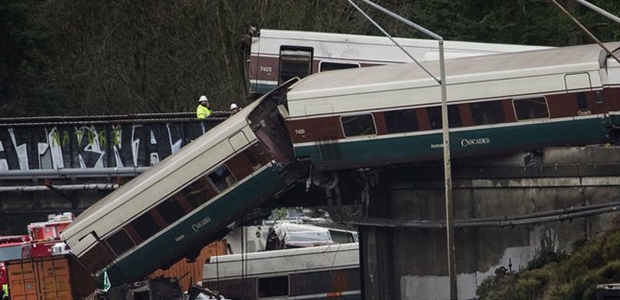
IMAGE: SEATTLE TIMES
NTSB: Inadequate Planning, Insufficient Training Led to Fatal 2017 Amtrak Derailment
Failure to provide an effective mitigation for a hazardous curve and inadequate training of a locomotive engineer led to the overspeed derailment of an Amtrak passenger train that hurtled off a railroad bridge and onto a busy DuPont, Wash., highway, the National Transportation Safety Board announced Tuesday.
Failure to provide an effective mitigation for a hazardous curve and inadequate training of a locomotive engineer led to the overspeed derailment of an Amtrak passenger train that hurtled off a railroad bridge and onto a busy DuPont, Wash., highway, the National Transportation Safety Board announced Tuesday.
On the morning of Dec. 18, 2017, Amtrak Cascades train 501 derailed on an overpass as it entered a 30-mph curve at an estimated 78 mph. It was the train’s inaugural run on the Point Defiance Bypass between Seattle and Portland, Oregon.
The lead locomotive and four rail cars fell onto Interstate 5, striking eight vehicles. Three of the 77 train passengers were killed, and 57 passengers and crewmembers aboard the train were injured, along with eight people on the highway.
“This is the third fatal overspeed passenger train derailment the NTSB has investigated since 2013,” NTSB Chairman Robert L. Sumwalt said. “All three have the same thing in common: each could have been prevented by Positive Train Control. This is why Positive Train Control is on the NTSB’s 2019-2020 Most Wanted List of Transportation Safety Improvements. The deadline for full implementation of PTC is rapidly approaching and the NTSB continues to advocate for the expedited implementation of this life-saving technology.”
In a public meeting held Tuesday, the NTSB said that the Central Puget Sound Regional Transit Authority failed to adequately address the hazard associated with a curve that required the train to slow from 79 mph to 30 to safety travel through it. Positive Train Control, a technology that prevents overspeed derailments, was not in use for the track at that curve, the board said.
While the engineer was somewhat familiar with the route due to observational rides and three training runs, it was the first time he operated the train on that route in revenue service, and on a locomotive on which he had very little experience. The NTSB determined the engineer had insufficient training on both the route and the equipment.
The locomotive was equipped with an inward-facing image recorder, which provided investigators with both a visual and audio recording of crewmember activities during the accident trip. The recording allowed investigators to reconstruct a second-by-second narrative of the actions, movements, and words of the engineer and conductor throughout the trip.
As the train passed the only sign warning of a speed reduction before the accident curve, the engineer was looking ahead, but the engineer told investigators that he did not see the sign. Recordings show that he took no action to reduce the train’s speed prior to the derailment.
Investigators also found the trainset involved in the crash, which did not meet current standards for crashworthiness and was only permitted to operate through a grandfathering agreement with the Federal Railroad Administration, was structurally vulnerable to high-energy collisions or derailments.
Responsibility for the planning, safety and oversight of the Cascades operation involved a number of organizations, including Amtrak, the Washington State Department of Transportation, the Federal Railroad Administration and the Central Puget Sound Regional Transit Authority. Investigators found there was a general sense that none of the participants fully understood the scope of their roles and responsibilities as they pertained to the safe operation of the service, which allowed critical safety areas to be unaddressed.
As a result of the investigation, the NTSB has issued a total of 26 safety recommendations to the Federal Railroad Administration, the Washington State Department of Transportation, Oregon Department of Transportation, Central Puget Sound Regional Transit Authority and the United States Department of Defense. The NTSB also reiterated three recommendations to the FRA.
The final report will be available in several weeks, but an abstract of the report including findings, probable cause, and safety recommendations can be read here.